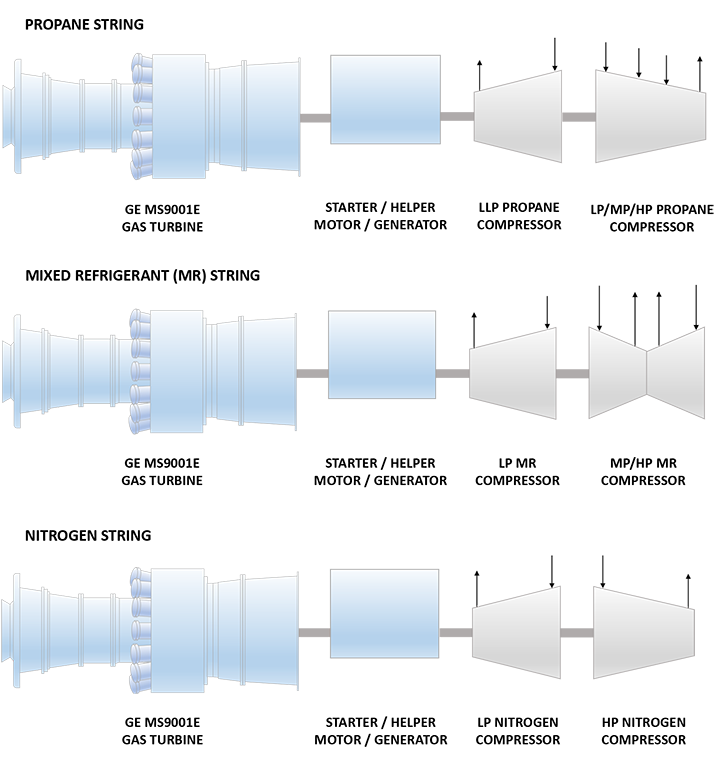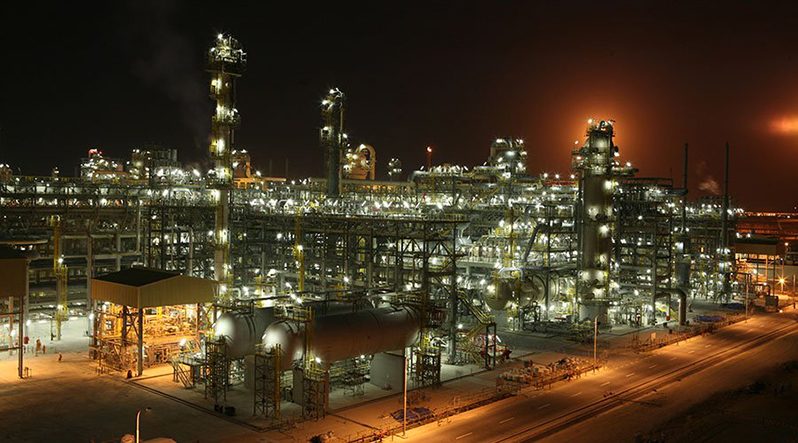In 1971, natural gas was discovered in the North Field, which is spread over a 6000 square kilometre area off the northeast coast of Qatar. The importance of this monumental discovery took a long time to percolate into commercial gain. Multiple drilling appraisals over 15 years confirmed that the field was the largest non-associated natural gas field in the world, home to almost 10% of the world’s known reserves. Suddenly Qatar found itself as owner of the third largest gas reserves in the world, after Russia and Iran. The North Field Bravo off-shore complex (NFB) was commissioned in 1996 and the RasGas Alpha off-shore complex (RGA) was started in 1999. The off-shore operations now comprise of 209 wells, which supply 18.5 billion cubic feet of sour gas daily.
In the mid-1990s Qatar invested millions of dollars to develop the port facilities and associated infrastructure at Ras Laffan, to facilitate the exploration, storage and export of its massive natural gas resources. The location, 80 kms north-east of Doha, was in ideal proximity to the North Field, as well as advantageously positioned on international maritime routes to the Far East and Europe. The on-shore operations at Ras Laffan Industrial City are spread over 7.80 square kilometres. By 2005 the port had shipped over 1000 cargos and by 2015 this number rose rapidly to 5000.
The history of LNG in Qatar started with the establishment of Qatar Liquefied Gas Company Limited (Qatargas 1) in 1984. In 1996, Qatar received delivery of its first LNG Vessel – “Al-Zubara”. Initially the operations proceeded at a glacial pace, with eight years underway before the first Sale and Purchase Agreement (SPA) was signed and 12 years for delivery of first LNG cargo. However, by 2010, Qatar had established itself as the largest producer of LNG in the world with a capacity to export 77 MMTPA of LNG.
In 2005, when train 3 at RasGas 2 went live, RasGas 1 was already operating its 2 trains successfully and trains 4 & 5 at RasGas 2 were soon to come onstream. Qatar was already an established LNG player in terms of infrastructure, technology, design and project specifications. The Ras Laffan Liquefied Natural Gas Company Limited 3 (RL3) was established to build 2 mega trains of capacity of 7.8 MMTPA each. In 2009, RasGas received delivery of its first Q-flex vessel “Al-Dafna” and also officially inaugurated train 6. The first cargo from RL3 was delivered to the Golden Pass regasification terminal in Texas, US. The next year, train 7 started operations.
The two trains together produce 15.6 MMTPA of LNG, in addition to 1.5 MMTPA of liquid petroleum gas (LPG) and 110,000 barrels per day of condensate. The trains are fed by an expansion to existing offshore facilities, including two offshore 12-well platforms and two 100 km 38-inch export pipelines to the shore. Helium recovered from the raw input stream is supplied to Ras Laffan Helium, a helium refining plant, operated by Qatargas.
In 2018, Qatargas and RasGas operations were merged into one global energy operator – Qatargas. Today the Ras Laffan Industrial City (RLIC) is home to a workforce of approximately 115,000 personnel. Qatargas is working towards Qatarization of its workforce and aims to accomplish over 50% Qatari workers by 2030. There is a strong focus on hiring, training and maintaining Qatari employees. Qatar Petroleum together with US University Texas A&M established, the Ras Laffan Emergency and Safety College for imparting training on industrial, hazardous materials, municipal, rescue and emergency medical services. In line with the goals of Qatar National Vision (QNV) 2030, Qatargas not only strives to exceed regulatory requirements, but also proactively works on initiatives for Green House Gas (GHG) management, sustainable waste management and waste reduction, wastewater management, air emission control and flare reduction. In 2015, the Jetty Boil-off Gas Recovery project (JBOG) was inaugurated in order to mitigate the flaring at Ras Laffan LNG loading berths by 90%.
OWNERSHIP (Equity %)
| Qatar Petroleum | 70.00% |
| ExxonMobil | 30.00% |
General Data
| Estimated Capital Cost (USD) | 4 B per Train |
| Plant Type | Onshore Stick-built |
| Plant Stage | Operating |
| Final Investment Decision (FID) Year | 2005 |
| FEED Contractor | Chiyoda Corporation |
| EPC Contractor | Chiyoda Corporation Technip |
| No. of Trains / capacity | 2 Trains / 7.8 MMTPA each |
| Production Start Year | 2009(Train 6) 2010 (Train 7) |
| Products | LNG, LPG, Condensate, Helium, Sulfur |
| Gas Type | Non-associated Gas (NAG) |
Technical Data
| Cooling Media | Seawater |
| Liquefaction Technology | APCI AP-X™ |
| Refrigeration Train Details: | |
| Propane String | |
| Driver | GE PG9171E DLN (Frame 9E) Heavy Duty Gas Turbine |
| Starter Helper Motor/Generator | ASI 45 MW Synchronous Motor / Generator |
| LLP Propane Compressor | MCL1402 GE (Nuovo Pignone) Centrifugal Compressor |
| LP/MP/HP Propane Compressor | 3MCL1403 GE (Nuovo Pignone) Centrifugal Compressor |
| Mixed Refrigerant String | |
| Driver | GE PG9171E DLN (Frame 9E) Heavy Duty Gas Turbine |
| Starter Helper Motor/Generator | ASI 45 MW Synchronous Motor / Generator |
| LP MR Compressor | MCL1805 GE (Nuovo Pignone) Centrifugal Compressor |
| MP/HP MR Compressor | 2BCL1006 GE (Nuovo Pignone) Radially Split Centrifugal Compressor |
| Nitrogen String | |
| Driver | GE PG9171E DLN (Frame 9E) Heavy Duty Gas Turbine |
| Starter Helper Motor/Generator | ASI 45 MW Synchronous Motor / Generator |
| LP Nitrogen Compressor | MCL1402 GE (Nuovo Pignone) Centrifugal Compressor |
| HP Nitrogen Compressor | BCL1003 GE (Nuovo Pignone) Radially Split Centrifugal Compressor |
Refrigeration Train Configuration

Key Facts
- RasGas 3’s key customers are Petronet LNG of India, KOGAS of Korea, EDF Trading of France and CPC Corporation of Taiwan. Each customers has signed long term SPAs of more than 15 years. India trades on FOB-basis (Free-on-Board), while the rest of the countries are supplied on DES-basis (Delivered Ex Ship).1
- RasGas 3’s Trains 6 & 7 consumed over 15,800 tons of structural steel, 31,000 tons of piping, 9,500 tons of cooling water lines, 3,400 km of E&I cables and 130,000 cubic meter of concrete. The project included 20,000 square meter of buildings and a staggering 57,000 tons of equipment. Over a period of 48 months, 15,000 construction workers were deployed on a 500,000 square meter site to put together 1,500 major pieces of equipment.2
- RasGas together with Qatargas operates the $1 Billion Jetty Boil-off Gas Recovery (JBOG) Project in Ras Laffan Industrial City. The JBOG project, touted as the biggest environmental project in the world, is designed to eliminate flaring by 90%. Annually, approximately 29 million cubic feet of natural gas, which was previously flared during LNG ship loading, is recovered and utilized in the LNG plants as feed or fuel. This is equivalent to saving 1.6 million tonnes of CO2 per year.3
- In 2014, India’s Dahej LNG terminal successfully completed its expansion to accommodate larger vessels. The first of world’s largest LNG carriers to arrive at the terminal in Gujarat was the Q-Max LNG tanker ‘Mekaines’, carrying cargo from RasGas.4
- The first liquid helium from the plant was produced in August 2005. The start-up of the US$ 115 million helium project was completed on time within budget and with an excellent safety record. The helium project is a joint venture owned by RasGas (I), RasGas (II) and Qatargas, and operated by RasGas Company Limited. The plant extracts, purifies and liquefies helium from the North Field. The first Ras Laffan Helium plant has a production capacity of approximately 9 tonnes per day of pure helium while the second Ras Laffan Helium Plant that started production in 2013 has a production capacity of approximately 17 tonnes per day of pure helium making the total liquid helium production capacity to 1.96 bscf per year.4
- Qatar is currently the world’s largest LNG producer, with an installed capacity of 77 MMTPA. In September 2018, Qatar Petroleum announced its plans to increase its LNG production capacity to 110 MMTPA, by adding four new trains, each of capacity 7.8 MMTPA. First LNG is expected to be produced by the end of 2023, with project completion planned for 2024.5,6
- RasGas 3 was the first LNG plant of its time to employ the world’s largest four-section Propane MR compressor.7
Source:
1. ‘The LNG industry GIIGNL Annual Report 2018’, GIIGNL Website, 2018
2. ‘RasGas Onshore/Onplot LNG Expansion (Trains 6 & 7)’, Consolidated Contractors Company Website
3. Alagos P. ‘Biggest environmental project in the world opens in Qatar’, Gulf Times Website, 29 April 2015
4. ‘Qatar Petroleum Annual Report 2014’, Qatar Petroleum Website, 2014
5. ‘Qatar Petroleum selects Chiyoda for North field production expansion FEED’, LNG World News Website, 19 March 2018
6. Iqbal A. ‘Qatar Petroleum to boost LNG output to 110 MTPA, says Kaabi’, Qatar Tribune Website, 27 September 2018
7. Dr. Akhtar S. ‘Driver Selection for LNG Compressors’, MSE Consultants Website, 14 December 2004






















































